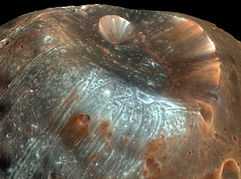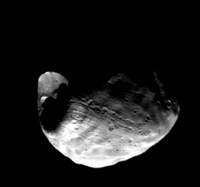Stickney (crater)
|
Stickney crater (at left) (Viking orbiter, 10 June 1977). | |
| Feature type | Impact crater |
|---|---|
| Location | 1°N 49°W / 1°N 49°W[1]Coordinates: 1°N 49°W / 1°N 49°W[2] |
| Dimensions | 9 km (5.6 mi) in diameter. |
| Discoverer | Asaph Hall |
| Naming | Chloe Angeline Stickney Hall |
Stickney is the largest crater on Phobos, which is a satellite of Mars. It is 9 km (5.6 mi) in diameter, taking up a substantial proportion of the moon's surface.
The crater is named after Chloe Angeline Stickney Hall, wife of Phobos's discoverer, Asaph Hall.[3] In 1878 Hall wrote that he "might have abandoned the search [for Martian satellites] had it not been for the encouragement of [his] wife."[4] The crater was named in 1973, based on Mariner 9 images, by an IAU nomenclature committee chaired by Carl Sagan.[5]

Stickney has a smaller crater within it, about 2 km (1.2 mi) in diameter, resulting from a later impact. In 2006 it was given the name Limtoc, after a character in Gulliver's Travels.[3]
Grooves and crater chains appear to radiate from Stickney. These have led to theories about the impact that formed Stickney nearly destroying the moon. However, evidence from the Mars Express orbiter indicate that they are unrelated to Stickney and may have been formed by material ejected from impacts on Mars.[6] The crater has a noticeable lineated texture on its interior walls, caused by landslides from materials falling into the crater.[7]
It is possible that Stickney is large enough to be seen with the naked eye from the surface of Mars.[8] It is located at the middle of the western edge of Phobos's face, on the Mars-facing side.
In culture
In Kim Stanley Robinson's science fiction novel Red Mars in the Mars trilogy series, the crater Stickney is the site of a crater-domed city used as the initial base of the first hundred colonists of Mars.
See also
- Deimos (moon)
- List of features on Phobos and Deimos
- Moons of Mars
References
- ↑ Blue, Jennifer. "Stickney". Gazetteer of Planetary Nomenclature. USGS Astrogeology Research Program.
- ↑ Blue, Jennifer. "Stickney". Gazetteer of Planetary Nomenclature. USGS Astrogeology Research Program.
- ↑ 3.0 3.1 Blue, Jennifer. "Phobos Nomenclature: Crater". Gazetteer of Planetary Nomenclature. Retrieved 24 July 2009.
- ↑ Hall, Asaph, Observations and orbits of the satellites of Mars, Washington: Government Printing Office, 1878 (quoted in Hall, Angelo, An astronomer's wife, Baltimore: Nunn and Company, 1908, p. 112).
- ↑ Veverka, Joseph et al. "A Mariner 9 atlas of the moons of Mars," Icarus 23, 206-289 (1974).
- ↑ Murray, John B. et al. "New evidence on the origin of Phobos' parallel grooves from HRSC Mars Express," Lunar and Planetary Science XXXVII (2006).
- ↑ "Phobos from 6,800 Kilometers (Color)". NASA/JPL-Caltech/University of Arizona. 9 April 2008. Retrieved 9 April 2008.
- ↑ Calculating the angular size of an object with a diameter of 9 kilometres (5.6 mi) at a distance of 9,250 kilometres (5,750 mi), yields 9/9250 * 206265 = 200 arcseconds. An object needs a size of 60 arcseconds to be resolved by the naked eye.
External links
| Wikimedia Commons has media related to Stickney (crater). |
- Flight around Phobos (animated movie)
- Stickney in High Resolution

